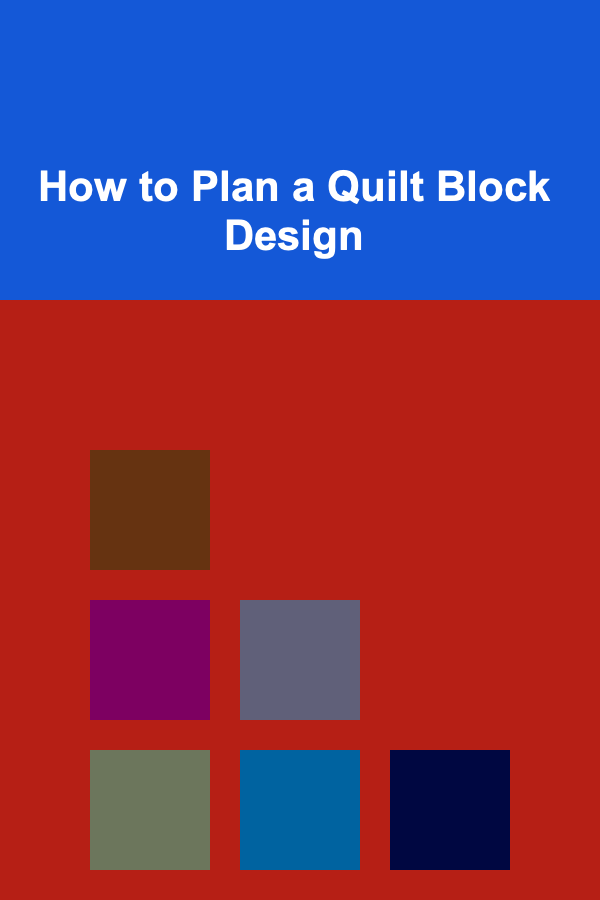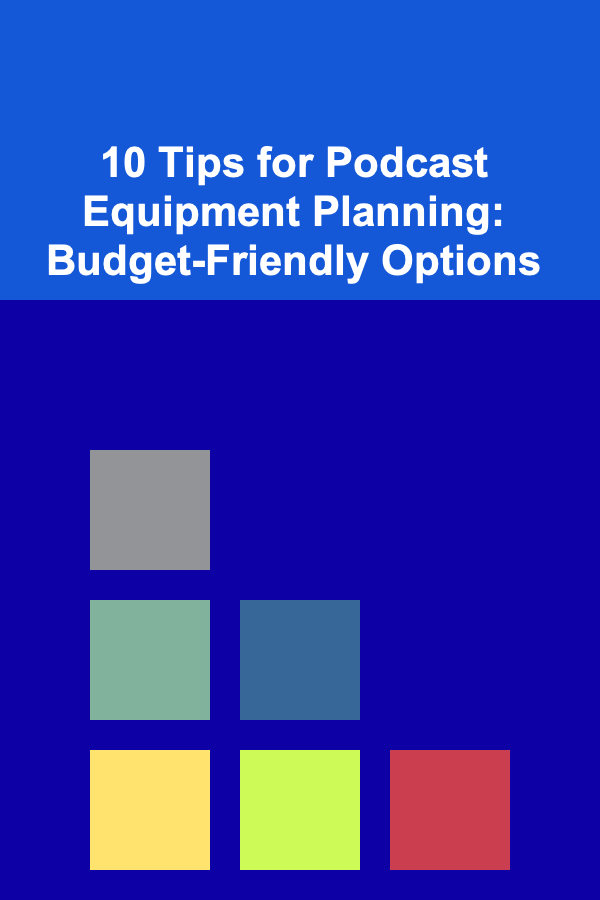
How to Plan a Quilt Block Design
ebook include PDF & Audio bundle (Micro Guide)
$12.99$7.99
Limited Time Offer! Order within the next:

Quilting is a time-honored craft that allows for immense creativity and expression through fabric. Whether you are a beginner or an experienced quilter, planning a quilt block design can be one of the most enjoyable parts of the quilting process. A well-planned quilt block design serves as the foundation for the overall quilt, ensuring a harmonious combination of colors, patterns, and shapes that create a visually stunning and cohesive finished product.
This article will guide you through the steps of planning a quilt block design, from the initial inspiration to the final touches. By the end of this guide, you will have a clear understanding of how to approach designing quilt blocks and how to incorporate your personal style into each creation.
Understanding the Basics of Quilt Blocks
Before diving into the planning process, it's important to understand the basics of quilt blocks. A quilt block is a square or rectangular unit of a quilt that features a specific pattern or design. These blocks are then pieced together to form the quilt top. Quilt blocks come in a wide variety of designs, ranging from simple geometric shapes to intricate patterns that require advanced piecing techniques.
Key Elements of a Quilt Block:
- Block Size: The size of the quilt block is crucial because it determines how many blocks will be needed to complete the quilt. Standard block sizes include 6-inch, 9-inch, 12-inch, and 16-inch blocks, but custom sizes are also common.
- Pattern and Design: Quilt blocks can be made from simple shapes such as squares, triangles, and rectangles, or more complex forms such as stars, pinwheels, or flowers. The design will dictate how the blocks are pieced together.
- Fabric Choices: The selection of fabrics for each block is one of the most important aspects of quilt design. Fabric choices can completely alter the mood and style of the quilt, from bold and modern to soft and traditional.
- Piecing Techniques: Different piecing techniques, such as strip piecing, paper piecing, or appliqué, can be used to create quilt blocks. Your choice of technique will impact the overall design and complexity of the block.
Finding Inspiration for Quilt Block Design
The first step in planning a quilt block design is gathering inspiration. The best quilt designs often come from a combination of personal tastes, traditional patterns, and contemporary trends. Here are some sources of inspiration to help you get started:
1. Traditional Quilt Patterns
Many quilters draw inspiration from traditional quilt patterns that have been passed down through generations. These patterns have stood the test of time and offer a sense of continuity and connection to quilting history. Popular traditional quilt block patterns include:
- Nine-Patch
- Log Cabin
- Flying Geese
- Churn Dash
- Stars (e.g., Ohio Star, Evening Star)
2. Nature and Surroundings
Nature can provide a wealth of inspiration for quilt block designs. From the colors of a sunset to the symmetry of a flower, nature's patterns are endless. Take a walk outside and observe how the natural world can influence your designs. For example, the shape of a leaf can be translated into a simple, elegant appliqué design.
3. Modern Quilt Trends
If you're looking for something more contemporary, modern quilting offers a fresh approach to traditional designs. Modern quilts tend to feature bold colors, asymmetry, and minimalist patterns. Look to modern quilters and online quilting communities for fresh ideas and trends.
4. Personal Interests and Themes
You may find inspiration in personal interests or themes, such as family, travel, or special occasions. Designing a quilt block based on these interests can add a deeply personal touch to your creation. For example, a quilt block inspired by a favorite holiday or a special memory can hold great sentimental value.
5. Fabric Collections
Sometimes the fabric itself will inspire the design. Many fabric companies release collections based on specific themes, and these collections often suggest a color palette or motif that can guide your block design. Pay attention to how different fabrics combine and how they can be used to create visual interest in a quilt.
Choosing the Right Block Design for Your Quilt
Once you have an idea of the kind of quilt you want to create, the next step is to choose the appropriate block design. Here are some key considerations when selecting a block design:
1. Skill Level
Consider your skill level when selecting a block design. If you are a beginner, you might want to start with simple designs such as squares, rectangles, or basic geometric shapes. As you gain experience, you can experiment with more intricate designs like stars, curves, or piecing complex shapes.
2. Complexity of the Block
The complexity of the block will impact how much time and effort you put into the quilt. Some blocks, such as the traditional Log Cabin or Rail Fence, are relatively straightforward and quick to piece together, while others, such as the Mariner's Compass or New York Beauty, require more advanced techniques and precision.
3. Size of the Quilt
The size of the quilt will dictate the number and size of the blocks needed. If you're making a large quilt, you may want to choose a simpler block design to keep the project manageable. Alternatively, a smaller quilt can feature intricate blocks for a more visually dynamic effect.
4. Overall Aesthetic
Consider how the block design will fit with the overall aesthetic of the quilt. If you are using a bold, modern fabric collection, you may want to select a clean, minimalist block design that complements the fabric. On the other hand, traditional quilt patterns often work well with vintage or floral fabrics.
Drafting Your Quilt Block Design
Once you've chosen a block design, it's time to start drafting the block layout. This step helps you visualize how the block will look once pieced together. You can draft your block design using graph paper or a computer design program.
1. Draw the Block
Start by sketching the block on graph paper, using squares to represent the finished size of the block. For example, if you're making a 12-inch block, each square on your graph paper will represent a 1-inch unit. Use this grid to plot out the shapes and lines of the block.
2. Select Color Placement
Once the block design is drafted, decide where each color or fabric will go. You can either plan this out by hand, using colored pencils or markers to fill in your sketch, or you can use fabric swatches to experiment with different color combinations.
3. Consider the Block's Rotation
Some quilt block designs look different depending on how they are rotated. For example, a star block may look completely different when rotated 90 degrees. Be sure to consider how the block will look in various orientations and how it will fit into the overall quilt layout.
Selecting Fabrics for Your Quilt Block Design
Choosing fabrics is one of the most exciting parts of planning a quilt block. The fabric you choose can make a significant impact on the overall appearance of your quilt. Here are some tips for selecting the best fabrics for your quilt block design:
1. Fabric Types
Different fabric types have different textures and weights, which can affect how they sew together. For quilt blocks, 100% cotton is a popular choice due to its durability, ease of handling, and wide variety of patterns and colors. However, you can experiment with other fabrics such as linen, flannel, or batik.
2. Color Palette
Choose a color palette that complements your design and the mood you want to create. A balanced palette can enhance the symmetry of the quilt, while contrasting colors can add interest and drama. Consider the overall color scheme of the quilt when selecting fabrics for each block.
3. Fabric Patterns
Quilt blocks can be made from solids, prints, or a combination of both. When using patterned fabrics, be mindful of how they interact with each other. Large prints may overwhelm small blocks, while tiny prints can add texture without taking away from the design.
Assembling the Quilt Blocks
After planning your block design and selecting fabrics, it's time to begin piecing the blocks together. Be sure to measure your pieces carefully and use accurate cutting techniques to ensure the blocks are uniform in size. As you sew the blocks together, take the time to press seams neatly and ensure that each block is square.
Conclusion
Planning a quilt block design is an exciting and rewarding process that involves creativity, technical skill, and thoughtful consideration of color and pattern. Whether you're working with traditional designs or creating something entirely unique, the design phase is where your vision for the quilt comes to life. With the right planning, you can create quilt blocks that not only fit together beautifully but also tell a story and reflect your personal style. Happy quilting!
Reading More From Our Other Websites
- [Organization Tip 101] How to Use Clear Containers for Easy Bathroom Organization
- [Personal Care Tips 101] How to Use Soap to Improve Skin Texture and Tone
- [Paragliding Tip 101] Understanding the Different Levels of Paragliding Certification and Their Safety Benefits
- [Home Maintenance 101] How to Protect Your Home from Water Damage in the Winter
- [Organization Tip 101] Best Organization Tools for Time Management
- [Home Party Planning 101] How to Choose the Right Party Supplies Without Overdoing It
- [Home Family Activity 101] How to Set Up an Indoor Family Obstacle Course
- [Organization Tip 101] Why You Should Utilize Multi-Functional Furniture for Space-Saving
- [Organization Tip 101] How to Optimize Your Gardening Workflow with Tool Organization
- [Home Pet Care 101] How to Bathe Your Pet Without Causing Stress

Essential Thrifty Clothing Shopping Strategies for Scoring Big Discounts
Read More
How to Design Eye-Catching Digital Ads for Maximum Engagement
Read More
How to Sanitize Your Home Without Using Harsh Chemicals
Read More
How to Understand Space Debris
Read More
10 Tips for Post-Processing Wildlife Photos Like a Pro
Read More
10 Tips for Podcast Equipment Planning: Budget-Friendly Options
Read MoreOther Products

Essential Thrifty Clothing Shopping Strategies for Scoring Big Discounts
Read More
How to Design Eye-Catching Digital Ads for Maximum Engagement
Read More
How to Sanitize Your Home Without Using Harsh Chemicals
Read More
How to Understand Space Debris
Read More
10 Tips for Post-Processing Wildlife Photos Like a Pro
Read More